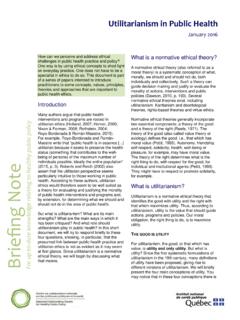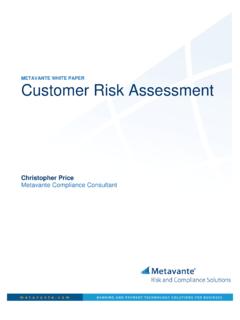Transcription of Four Types of Impact Assessment Used in Canada - NCCHPP
1 National Collaborating Centrefor Healthy Public PolicyCOMPARATIVE TABLE | SEPTEMBER 2010 FOUR Types OF Impact Assessment used IN National Collaborating Centrefor Healthy Public PolicyCOMPARATIVE TABLE | SEPTEMBER 2010 FOUR Types OF Impact Assessment used IN Canada AUTHOR Anika Mendell National Collaborating Centre for Healthy Public Policy LAYOUT Isabelle H mon National Collaborating Centre for Healthy Public Policy ACKNOWLEDGMENTS The author would like to acknowledge the valuable contributions of Robert Rattle, Roy Kwiatkowski, Josh Marko, Catherine Elliot and Louise St-Pierre to this document.
2 Production of this document has been made possible through a financial contribution from the Public Health Agency of Canada through funding for the National Collaborating Centre for Healthy Public Policy ( NCCHPP ). The National Collaborating Centre for Healthy Public Policy is hosted by the Institut national de sant publique du Qu bec (INSPQ), a leading centre in public health in Canada . The views expressed herein do not necessarily represent the views of the Public Health Agency of Canada . This document is available in its entirety in electronic format (PDF) on the Institut national de sant publique du Qu bec website at: and on the National Collaborating Centre for Healthy Public Policy website at: La version fran aise est disponible sur les sites Web du Centre de collaboration nationale sur les politiques publiques et la sant (CCNPPS) au et de l Institut national de sant publique du Qu bec au Reproductions for private study or research purposes are authorized by virtue of Article 29 of the Copyright Act.
3 Any other use must be authorized by the Government of Qu bec, which holds the exclusive intellectual property rights for this document. Authorization may be obtained by submitting a request to the central clearing house of the Service de la gestion des droits d auteur of Les Publications du Qu bec, using the online form at: or by sending an e-mail to Information contained in the document may be cited provided that the source is mentioned. LEGAL DEPOSIT 4th QUARTER 2011 BIBLIOTH QUE ET ARCHIVES NATIONALES DU QU BEC LIBRARY AND ARCHIVES Canada ISBN: 978-2-550-62449-3 (FRENCH PRINTED VERSION) ISBN: 978-2-550-62450-9 (FRENCH PDF) ISBN: 978-2-550-62451-6 (PRINTED VERSION) ISBN.
4 978-2-550-62452-3 (PDF) Gouvernement du Qu bec (2011) Four Types of Impact Assessment used in Canada ABOUT THE NATIONAL COLLABORATING CENTRE FOR HEALTHY PUBLIC POLICY The National Collaborating Centre for Healthy Public Policy ( NCCHPP ) seeks to increase the expertise of public health actors across Canada in healthy public policy through the development, sharing and use of knowledge. The NCCHPP is one of six Centres financed by the Public Health Agency of Canada . The six Centres form a network across Canada , each hosted by a different institution and each focusing on a specific topic linked to public health. In addition to the Centres individual contributions, the network of Collaborating Centres provides focal points for the exchange and common production of knowledge relating to these topics.
5 National Collaborating Centre for Healthy Public Policy I Institut national de sant publique du Qu bec Four Types of Impact Assessment used in Canada National Collaborating Centre for Healthy Public Policy III Institut national de sant publique du Qu bec TABLE OF CONTENTS 1 Impact Assessment : FOUR TOOLS used IN Canada .. 1 2 COMPARISON OF FOUR Types OF Impact Assessment used IN Canada .. 3 BIBLIOGRAPHY .. 17 FURTHER 23 Four Types of Impact Assessment used in Canada National Collaborating Centre for Healthy Public Policy 1 Institut national de sant publique du Qu bec 1 Impact Assessment : FOUR TOOLS used IN Canada Prospective Impact Assessment of projects, programs and policies has occurred in Canada since 1974, when a federal Cabinet policy was developed to review the environmental impacts of federal decisions.
6 Today, various Types of Impact Assessment are practised in Canada and abroad, in order to identify the unintended effects of public- and private-sector initiatives on human health and/or on the environment. The existence of a large variety of Impact assessments has led to a certain amount of confusion (Rattle, 2009), as there are no definite separations between approaches. For example, Environmental Impact Assessments may (or may not) evaluate Impact on human health or on the social determinants of health; Health Impact Assessments may (or may not) address issues of equity, while Equity-focused Health Impact Assessments explicitly evaluate this dimension.
7 The objective of this table is to clarify four different approaches that are used in Canada : Health Impact Assessment (HIA), Environmental Impact Assessment (EIA), Strategic Environmental Assessment (SEA) and Risk Assessment (RA). Clearly, this table does not account for all of the Impact approaches being used today or all of the variants that may be found in the literature. However, it should provide a general sense of what four Types of Impact Assessment practised in Canada try to achieve, and how. Four Types of Impact Assessment used in Canada 2 COMPARISON OF FOUR Types OF Impact Assessment used IN Canada Health Impact Assessment (HIA) Environmental Impact Assessment (EIA) Strategic Environmental Assessment (SEA) Risk Assessment (RA) Definition.
8 A combination of procedures, methods and tools by which a policy, program or project may be judged as to its potential effects on the health of a population, and the distribution of those effects within the population (WHO, 1999, ). In general, environmental Assessment is a process to predict the environmental effects of proposed initiatives before they are carried out (Canadian Environmental Assessment Agency, 2010). An integrated EIA, which combines heath, social, economic, cultural and psychological well-being as well as the physical, biological and geochemical environments, provides a holistic understanding of the complex interrelationships between the human and natural environments that are key to health (Kwiatkowski & Ooi, 2003, ).
9 A systematic, comprehensive process of evaluating the environmental effects of a proposed policy, plan or program and its alternatives (Parks Canada , 2009a, ). The use of the factual base to define the health effects of exposure of individuals or populations to hazardous materials and situations (Mindell & Joffe, 2003, ). Level of Analysis Policy, program or project Project Policy, program or plan Substance / exposure National Collaborating Centre for Healthy Public Policy 3 Institut national de sant publique du Qu bec Four Types of Impact Assessment used in Canada COMPARISON OF FOUR Types OF Impact Assessment used IN Canada (.)
10 Health Impact Assessment (HIA) Environmental Impact Assessment (EIA) Strategic Environmental Assessment (SEA) Risk Assessment (RA) Frameworks Ottawa Charter for Health Promotion (WHO, 1986); Environmental Impact Assessment ; Gothenburg Consensus Paper (WHO, 1999); Strategies for Population Health: Investing in the Health of Canadians (Federal, Provincial and Territorial Advisory Committee on Population Health, 1994). Toxicology, epidemiology, risk Assessment , environmental science (Personal communication, July 22, 2010). Toxicology, epidemiology, risk Assessment , environmental science (Personal communication, July 22, 2010).











